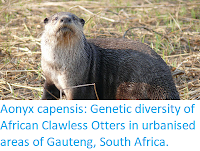Leptarctus primus is an Carnivoran Mammal known from the Miocene of the United States. Its relatioship to modern groups is somewhat uncertain, with the species previously regarded as a Bear or a Raccoon, and currently thought to be related to the Mustelids (Weasels, Badgers and Otters). Similarly the diet of Leptarctus primus, and therefore the ecological nich it occupied, has been the subject of some debate, with its skull being interpreted as suggesting a diet similar to that of the carnivorous American Badger, Taxidea taxus, the omnivorous Raccoon, Procyon lotor, the leaf-eating Koala, Phascolarctus cinereus, the frugivorous Kinkajou, Potos flavus, the insectivorous Bat-eared Fox, Otocyon megalotis, or the omnivorous Raccoon Dog, Nyctereutes procyonoides.
In a paper published in the Journal of Vertebrate Paleontology on 22 February 2019, Alixandra Prybyla of the Department of Ecology, Evolution, and Environmental Biology at Columbia University, and the Division of Paleontology at the American Museum of Natural History, Zhijie Jack Tseng of the Department of Pathology and Anatomical Sciences at the State University of New York, Buffalo, and John Flynn, also of the Division of Paleontology at the American Museum of Natural History, and of the Department of Earth and Environmental Science at Columbia University, and the Richard Gilder Graduate School, describe the results of a study of Leptarctus primus in which computer simulation of cranial biomechanics is used to compare it to a variety of living species.
Prybyla et al. CT-scanned the crania of a number specimens using high-resolution micro-computed tomography with the GE v|tome|x s 180/240 kV dual-tube HRX μCT system at the Microscopy and Imaging Facility of the American Museum of Natural History. As well as several specimens of Leptarctus primus, the study included Hypsoparia bozemanensis, a second Miocene North American Carnivoran, which is known only from a single fragmentary specimen, and which some palaeontologists ague is a specimen of Leptarctus primus, as well as the Eocene Carnivoran Oodectes herpestoides, and the Eocene Hyeanadont Creodont Thinocyon velox. The study also included the modern Ring-tailed Cat, Bassariscus astutus, Wolverine, Gulo gulo, Kinkajou, Potos flavus, Eastern Spotted Skunk, Spilogale putorius, American Badger, Taxidea taxus, Grey Fox, Urocyon cinereoargenteus, Wolf, Canis lupus, Black-backed Jackal, Canis mesomelas, Polar Bear, Ursus maritimus, Brown Bear, Ursus arctos, African Wild Dog, Lycaon pictus, Spotted Hyena, Crocuta crocuta, Brown Hyena, Parahyaena brunnea, Red Panda, Ailurus fulgens, Leopard, Panthera pardus, Javan Mongoose, Herpestes javanicus, Striped Skunk, Mephitis mephitis, and the Raccoon, Procyon lotor.
Leptarctus primus skull reconstructions and models. (A) AMNH FM 25385, reconstruction of missing or damaged morphology, accounted for in virtual reconstruction: occipital condyles, anterior cranial crushing, and a loss of maxillary canines. The protrusion of the left sagittal crest has broken off; it has not been reattached. The neotype (AMNH FM 18241) of Leptarctus primus was used as a reference for the reconstruction. (B) CTscanned, evaluated to identify collapsed elements and holes, and slice artifacts produced by the coronal image stack compilation smoothed in Mimics to create a computerised model of the original skull. (C) model (B)’s triangular surface elements lowered via the ‘decimation function’ to a more uniform number (between 200,000 and 280,000 finite elements), reducing the topical quality of the mesh but standardising it with other models. Because canines are lacking in AMNH FM 18241, the canines were transferred digitally from the best-preserved Leptarctus specimen (AMNH FM 54198) in the collection. Prybyla et al. (2019).
This data set was used to create a three dimensional stress distribution maps of the crania, showing where stress would be applied during biting, where the greatest bite force would be applied, and the strength of this bite force, with a view to understanding the feeding mechanics of Leptarctus primus, and therefore estimate its ecological role.
Von Mises stress distributions in crania of extinct Leptarctus primus and extant Taxidea taxus, Potos flavus, Lycaon pictus, and Gulo gulo. Unilateral bites are shown for the right upper tooth row, with C (canine), P2 (second premolar), P3 (third premolar), P4 (fourth premolar), and M1 (first molar). Cooler (darker) shades indicate lower stress; warmer (lighter) shades indicate higher stress. Prybyla et al. (2019).
Leptarctus primus was found to be most similar to the American Badger, Taxidea taxus,
a primarily carnivorous species, which has some omnivorous habits. The
diet of the American Badger comprises mostly small Vertebrates, such as
Snakes, and Birds, supplemented secondarily by opportunistic omnivorous
feeding on Insects, eggs, seeds, Fungi, etc.. It also shows some
similarities to the African Wild Dog, Lycaon pictus, another largely carnivorous species the omnivorous Raccoon, Procyon lotor, and the Wolverine, Gulo gulo, a carnivore which feeds largely on scavenged carrion, but again is opportunistically omnivorous.
See also...
Follow Sciency Thoughts on Facebook.








